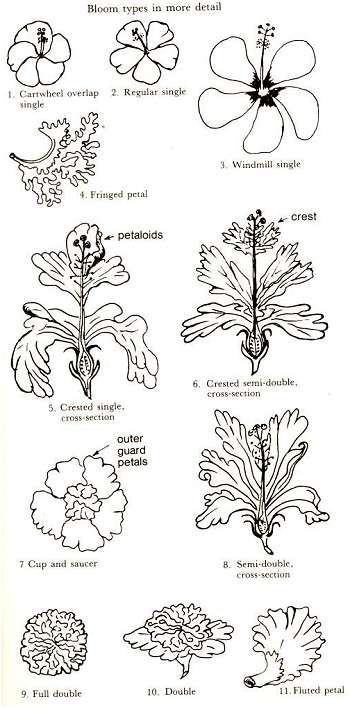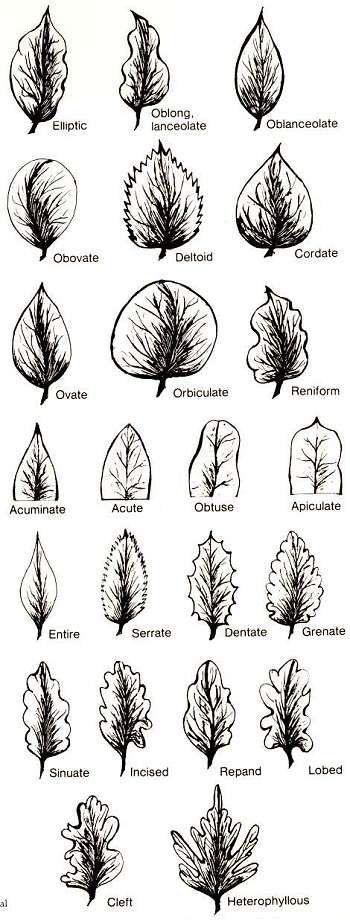The interest in hibiscus, and the ease of hybridising
these plants has led to a vast number of named cultivars. To list all of
these hybrids with descriptions would require a book similar in length to
an encyclopedia. In Hawaii during the 1920s there were over 3000 named
varieties, but many of these have now been culled out as new, better
varieties have been produced. Today, there are many beautiful cultivars
and we have selected what we believe to be the best to include in this
catalogue.
Terms and Definitions
The descriptions are based on growth in a normal garden
situation using the cultural practices recommended.Variety or
Cultivar Name
The names used in this catalogue are either the names
registered with the American or Australian Hibiscus Society, or the names
accepted within the nursery industries in those countries and in general
use. It may be noted here that several varieties are known by different
names in different places, a legacy of days gone by before the hibiscus
societies became active. In these cases we have included both names.
Colour Description
The colour descriptions have been written with simplicity
in mind. They are not precise descriptions, but have been drawn up so that
you can quickly and easily determine the basic colour of the bloom, during
the main flowering period.
Bloom Size
The bloom sizes listed below are indicative of the size of
blooms produced on plants grown in a normal garden with regular watering,
fertilising and spraying during the flowering season.
Miniature: under 10 cm (4 in)
Medium: 10 15 cm (4 6 in)
Large: 15 20 cm (6 8 in)
Extra Large: 20 cm (8 in) and over
Blooming abilities
Prolific: Produces a regular supply of
blooms in large quantities.
Good : Produces a regular supply of blooms in rewarding
quantities.
Fair: Produces a reasonable supply of blooms, however
not noted for its blooming abilities.
Poor: Blooms in limited quantities.
Bloom Description
Ruffled: Frilly, ruffled edges on petals.
Tufted: Small upstanding creases on inside edge
of petals.
Crested: This refers to the petaloids that occur on the
style tip of some single and semi double blooms.
Crippled: This term refers to a bloom that will
occasionally have a wide separation in some of the base petals thus
interrupting their symmetry.
Self Coloured: Means simply that the portion of
the bloom referred to is the same as the main colour of that bloom.
Eye: The part of the bloom at the base of the
petals.
Zone: The area adjacent to the eye portion.
Halo: Small band between the eye zone and petals.
Stigma Pads: The five small velvety, coloured
pads on the tip of the staminal column which receive pollen to produce
seed.
Staminal Column: The long thin column extending
from the centre of the bloom with anthers and stigma pads. In doubles this
part may not be entire.
Overlay: Refers to colour that appears to be laid
over another more prominent colour.
Overlapped: Petals overlap one another.
Recurved: The outer edges of the petals curve
backwards.
Texture: This is the relative thickness of the
bloom.
Bloom Life
Hybridisers in recent years have improved the texture of blooms in many of
the modern varieties, and hence have increased the life of the bloom, both
on and off the bush. Where this feature of a variety is significant the
term two or three day bloom is used.
Height of Bushes
The heights listed opposite describe the adult height of the variety when
grown under normal garden conditions with annual pruning.
Low: Under 1.2 m (4 ft)
Average: 1.2 - 2.2 m (4 - 7 ft)
Tall: 2.2 - 3.2 m (7 - 10 ft)
Very Tall: Above 3.2 m (10 ft)
Grafting
This description indicates that the growth habit and blooming abilities of
the variety are greatly improved by grafting onto a hardy rootstock. Many
hibiscus benefit from grafting.
 |
Flower Types
There are nine main types of hibiscus blossoms, with many variations of
these nine types. Even on the same bush at the same time there maybe a
variation in shape and colouring. Here are the characteristic types:
1. Cartwheel overlap single: Petals are completely
overlapped to tips giving a regular, circular appearance. Texture is apt
to be heavily veined, ruffly and heavy. A strong sturdy flower.
Examples: `Annie Wood', `Nathan Charles', `Ross Estey'.
2. Regular single: The petals are separated for less
than half the distance from the edge, giving a regular, scalloped
appearance. Most singles fall into this type. Petals may be partly
overlapped, ruffled, funnel shaped, flat or reflexed.
Examples: `Dawn', `Delight', `Scarlet Giant'.
3. Windmill single: Petals are narrow and separated for
nearly their entire lengths. Texture is usually light and thin.
Examples: `Fantasia' (`Dainty Pink'), `Rose Scott', `Wrightii'.
4. Fringed single: Edges of petals are split and
fringed. Staminal column long and pendulous.
Examples: `Andersonii', 'Sylvia Goodman', H. schizopetalus and its
hybrids.
5. Crested single: Basic type may be any of the above,
but the normal bloom exhibits petaloids on the end of the staminal column
forming a perfect crest. `Crest' can refer either to the little petaloids
that occur on the style tip of a single bloom, or to the secondary petals
on a semi double or double bloom.
Examples: `El Capitolio', `Katy D'.
6. Crested semi double: Loose double appearance, with
petaloids arising from staminal column. Stigma usually present.
Examples: `Crown of Warringah', `Lady Adele'.
7. Cup and saucer: Outside guard petals follow single
form. Centre tuft, or petaloids all arise from centre and are distinctly
separated from guard petals.
Examples: `Lord of the Isles' (`Daffodil'), 'Marjorie Beard', `Prince of
Orange'.
8. Semi-double: Loose petal formation with a few petals
that may be twisted or quilted. All petaloids form from the base of the
bloom. Staminal column may be missing.
Examples: 'Isobel Beard', `Cile Tinney', 'Rai Wha'.
9. Full double: Many petals and petaloids in a tight
formation, giving a full ball shaped appearance. Staminal column usually
missing. Examples: `King Kalakaua', `Mrs George Davis' ('Kona'),
`Peachblow'.
|


